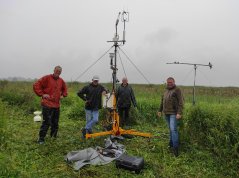
News
Research on greenhouse gas in Camphuis Polder
Since mid-August there has been a strange looking construction in the bog of Camphuis Polder near Groningen. Researchers from Wageningen University & Research are using it to measure how much greenhouse gas is captured and how much is released into the polder.
The climate is changing because increasingly more greenhouse gases like CO2 and methane (CH4) are being released into the air, for example by fossil fuels used to produce energy. Peatlands like Camphuis Polder can capture CO2 as long as the area remains wet enough; peat that dries out releases that same CO2 into the atmosphere. This is why keeping peatlands wet was one of the measures included in the Climate Agreement and why the water level in Camphuis Polder and Westerbroek was raised last year.

Measurements
In peatlands plant residues remain on the soil, creating a peat layer that consists mainly of carbon compounds. Wetting the peatland enlarges the bog: more plants grow and they absorb and capture CO2 from the air. Simultaneously, this wetting can also cause extra emissions of the strong greenhouse gas methane. It is not yet known how large these effects are and under what circumstances they occur. Natuurmonumenten, Staatsbosbeheer and Landschappen NL hope to get more clarity about this question by taking measurements together with researchers from WUR.
Natural climate buffer
A nature reserve like Camphuis Polder is a natural climate buffer: it allows room for nature and it offers solutions to climate problems and local needs such as water safety, CO2 reduction and recreation. Natural climate buffers provide space for rainwater under extreme weather conditions, but to do so nature reserves must be sufficiently robust. Earlier this year measurements were taken in De Onlanden nature reserve. The measurements will continue for three years. The results of this study could help to provide advice to managers of peatlands and bogs.
The measures on wetting the land in question and the study were made possible in part by the Ministry of Agriculture, Nature and Food Quality in the framework of the policy-supporting research theme and associated funding instrument on climate-smart forest, nature and wood management.